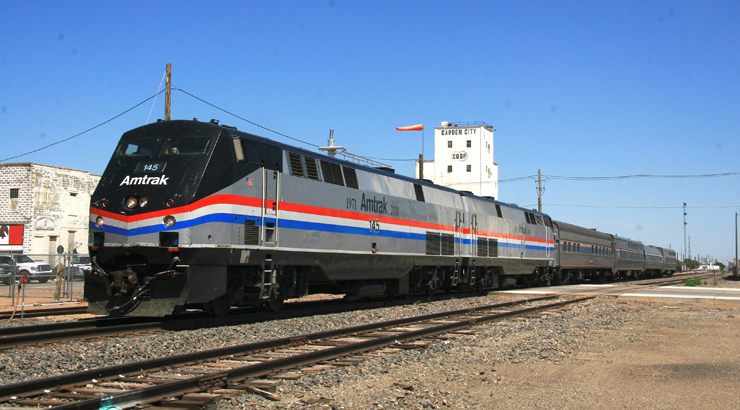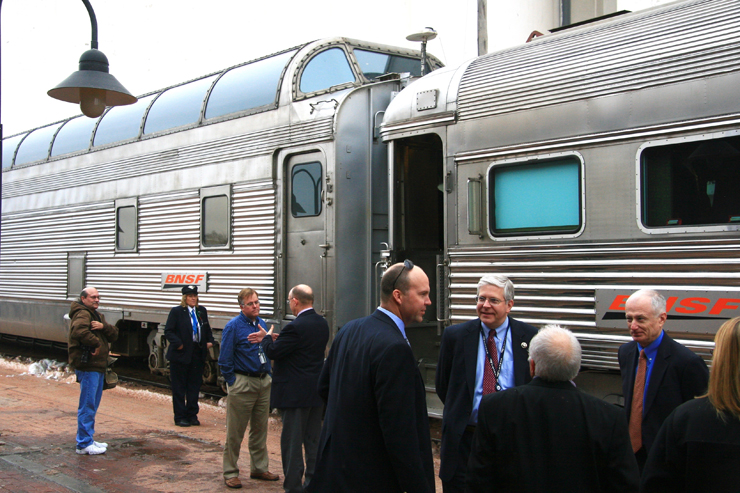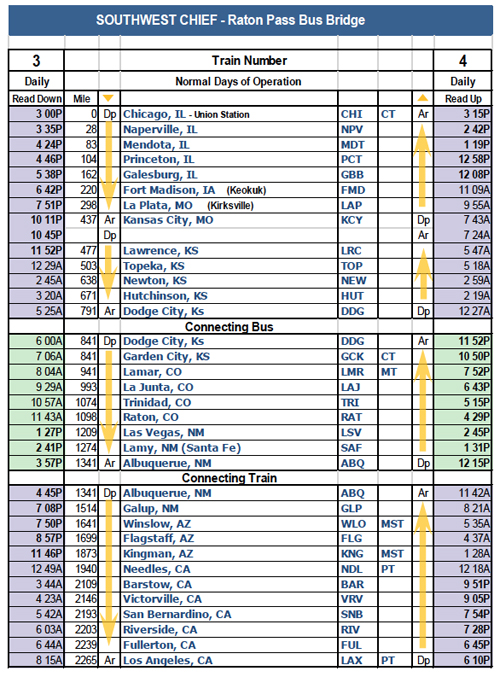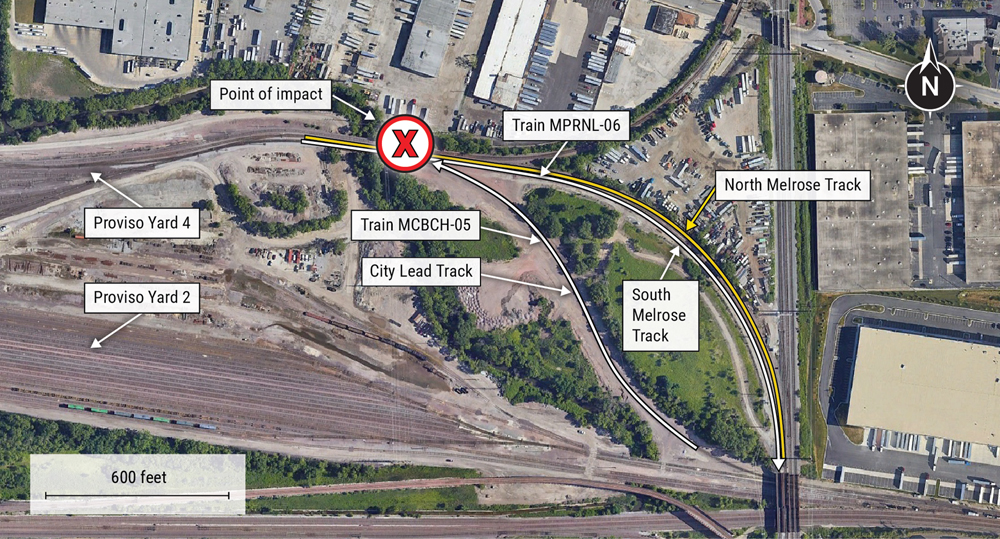RATON, N.M. — Amtrak will not operate passenger trains on lines without positive train control after Dec. 31, 2018, a top official for the passenger railroad says — a decision which could lead to the discontinuance of eight trains, not just the Southwest Chief.
Senior Vice President and Chief Commercial Officer Stephen Gardner told this to officials at a meeting in Raton, N.M., on the future of the Chief, according to individuals in attendance at the meeting. He also said that the Amtrak board of directors has mandated the policy, despite exemptions for the technology’s implementation granted by the Federal Railroad Administration.
The policy means the Amtrak Board would insist the following trains on FRA-exempted routes be discontinued:
- Southwest Chief: between La Junta, Colo., and Dailies, N.M., and through Topeka, Kan.
- Cardinal: over the Buckingham Branch Railroad between Orange and Clifton Forge, Va.
- California Zephyr: 152 miles of UP’s Green River subdivision west of Grand Junction, Colo.
- Texas Eagle: 110 miles of UP’s Desoto subdivision south of St. Louis, Mo.
- Downeaster: north of Haverhill, Mass., to Brunswick, Maine., on Pan Am Railways
- Vermonter: north of Springfield, Mass., on the New England Central
- Ethan Allen: on Vermont Railway east of Whitehall, N.Y.
- City of New Orleans: a total of 18 miles on Canadian National around Memphis, Tenn., and New Orleans
Gardner was speaking at the meeting in Raton last week hosted by Colfax County, N.M., for more than 40 officials whose cities and states have already invested millions of dollars in matching funds to three approved federal grants designed to shore up the Southwest Chief’s route.
Steve Cottrell was there. He’s the Assistant City Manager of Garden City, Kan., the sponsor of the first Transportation Infrastructure Generating Economic Recovery grant to improve the roadbed and replace 1955-vintage rails on the line. Cottrell tells Trains News Wire that Gardner claimed several times that Amtrak “had no preconceived end game in mind” when he delivered a presentation that outlined exactly that: a bus bridge from either Dodge City, Kan., or La Junta, Colo., to Albuquerque, N.M.
“I made the statement to him,” says Cottrell, “that it would have been a much more pleasant meeting had Amtrak sat down with the [Southwest Chief] Coalition, and state DOT’s prior to making such statements because we want to work out how to get the TIGER 9 [grant, the latest providing funding to maintain the Chief route] off the ground and get a commitment for their share of the money.”
Cottrell adds, “If it’s going to take working out another 3- to 5-year plan for the improvements, either to the railroad or start some phased installation of PTC, so be it, but to get blindsided by this bus bridge thing and then come in and say they have no preconceived idea just kind of set a negative tone to the meeting that shouldn’t have had to be that way.”
The PowerPoint, obtained separately by Trains News Wire, goes into great detail about the two alternatives, including consists of the replacement trains (“2 locos, 2 coaches, 1 coach-bag, 1 café”), revised schedules for the train-bus combination, and offers “Ballpark” upfront capital expenditures, ranging from $4 million to more than $13 million, for layover/turning facilities at Dodge City, Kan., and Albuquerque. It It also outlines Amtrak’s insistence for positive train control without mentioning the fact that under 49 CFR section 236.1019 (c) (3), the route is entitled to an FRA “limited operations exception”
The presentation claims a funding need of $157.2 million in “capital and operating expenses” through 2024 (including $55 million for PTC) and takes a stab at projecting revenue losses. The report claims the truncated coach-bus-coach trains would generate between $23.2 million to $24.2 million of revenue, depending upon the option.
This means Amtrak believes the train would maintain its current level of coach patronage despite the lengthy bus-bridge operation. An analysis by Trains News Wire using Amtrak’s own data from the company’s year-end fiscal 2017 revenue and ridership report shows coach passengers on the through Chicago-Los Angeles Chief spent $23.7 million on tickets. Sleeping car passengers spent $19.7 million, or 45 percent of the $43.5 million total.
As a point of reference for revenue the train now generates, as of August 25 for the following 30 days, the price for one adult traveling between Chicago and Los Angeles in coach ranges between $142 to $177, while roomettes are priced, depending on the departure day, at $670 (4 days), $794 (9 days), $926 (9 days), $1,058 (6 days). Roomettes (36 available rooms) were sold out (36 available rooms) on two dates.

















To all if Anderson gets his way every route will shut down on New Years Day and Amtrak will cease to exist. for example If Anderson chooses to end service he will cancel studdies on the Pioneer, Desert Wind, and the Zephyr . the Zephyr connects Junction Colorado with Salt Lake via Soldier Summit. I hate to tell you this UNION PACIFIC AND BNSF DON’T HAVE THE TIME OR THE RESOURCES TO IMPLEMENT PTC ON THE GREEN RIVER SUB OR SOLDIER SUMMIT! UP and BNSF are installing it but are out of money and only a few signals are installed. Mounds to Sphinx is PTC operated they installed it last year but Sphinx to Cisco does not have PTC and the area is a radio deadzone. That is the whole Green River Sub. Hatch, Romney, Lee, Curtis, and Stewart have called Anderson out Why! BECAUSE THE GREEN RIVER SUB GOES THROUGH THEIR DISTRICTS! If Anderson gets his way 1. no excisions to to all nine of Utah’s nation parks, 2. Zephyr will stop in Junction Colorado and service to Green River, Helper Junction, and Provo will cease, 3. Grayhound will lose their connection at Salt Lake, 4. The Amtrak study to restore the Desert Wind and Pioneer will be canceled, and 5. Amtrak will be cutoff from the west coast. Anderson leave Zephyr alone this train is the artery of this nation if you cancel service Amtrak as a whole will shut down same goes for the Southwest Limited, the Builder, and the Chief.
That does it I want Anderson, Ames, and Macalliff to resign immediately. This is not Southwest Airlines we don’t serve passengers junk food, routes are controlled by the government and the states not the railroads, and Amtrak answers to Congress not the FRA board of Directors or the robber barons. Amtrak is a government entity if Anderson does not accept this fact I will go to Trump and will remove him by force. He is shoving Southwest Airline’s model down our throats to give them service. Amtrak is not Southwest Airlines Anderson stop planting your pump and dump regulations on our railroads. You answer to the government not the corporation and personally I want Amtrak Corporation dissolved they killed 15 routes and if Anderson gets his way every Amtrak route will be shut down and Amtrak will cease to exist. We need these routes PTC or no PTC and Anderson I want you and your board to step down we don’t have the money and you forcing people to do your bidding is destroying Amtrak. Now do things the the US government and the railroad way and not the Southwest Airlines way or get out and we will find a railroader to take your place. THIS IS SOUTHWEST AIRLINES ANDERSON SHAPE UP OR GET OUT!
What IF Metro North does not have PTC between Rochelle interlocking and New Haven in parts or total? I doubt NY-Boston trains will stop. Complete subterfuge from Amtrak.
Paul Dolhy: Amtrak serves a useful purpose…when it works. Problem is, for whatever reason (I will not speculate as to what I think the reason is) it does not appear to be working. I do not think it is feasible to abolish Amtrak because of factors discussed earlier, but, and this is a strictly personal opinion upon which you should not rely nor use as the basis for any course of action, we need to have a serious national conversation about ground transportation.
For what it’s worth, Greyhound is pulling out of its less profitable markets as well. In many markets at the moment it is private vehicle, air (if you have a service available), or Right Foot Express. This is not acceptable, not in my opinion.
In Canada the lack of bus service in the western provinces is causing the provincial governments to explore publicly owned entities (e.g., Crown Corporations) to provide service. In Ontario, for example, Ontario Northland – which had been on the ropes due to cutbacks by a conservative provincial government a few years ago, is being looked at again, this time with an eye to expanding services. The ONR train which went from North Bay to Toronto might (we can hope) be revived, and there is discussion of rail service between Sudbury and Sault Sainte Marie. But in the US at the moment I cannot see any hope of any similar conversation.
Once again in Canada, there is precedent for this sort of thing. In Alberta for example, there is the Ontario Treasury Branch, which is a full service bank owned by the Provincial government. It is a Crown Corporation instituted in the 1930’s at a time when the established banks would not provide services in Alberta. They wouldn’t, so the government stepped in and did it.
As far as the Amtrak stock issue is concerned, the common stock is held by the railroads and successor entities. It is non-voting, and there is a question as to whether it can be traded. It is not listed on any exchange of which I am aware, although it appears it can be traded on an OTC basis. The preferred stock, which is voting, appears to be held by some branch of the US Federal government. At the beginning of the year there were 109,396,994 shares outstanding, with a par value of $100/share. These shares do not appear to be available on any market.
The above remarks are general in nature and do not form the basis for an attorney/client relationship. They do not constitute legal advice. I am not your attorney. Go find your own damn lawyer.
Lets make it simple abolish Amtrack ,in doing so you get rid of the politicians that don,t have a clue on running a railroad but keep putting their nose where it doesn,t belong including the Amtrack board members , let Warren Buffet and the other class 1 owners put a joint passenger service together , not like the old days when each one had their own ,they run a great freight business I,m sure they would do the same for a passenger service ,and this way government is out of the picture!
I don’t know about ownership, but courts have proclaimed Amtrak to be a government agency while Amtrak and Congress have often claimed that it was not. See https://caselaw.findlaw.com/us-6th-circuit/1624831.html.
And why is Amtrak stock owned by those railroads and how useful is it, anyway? And why is a railroad (basically Penn Central) posing as an insurance company (American premier underwriters or great American insurance or whatever it’s called)? Maybe it’s time for Penn Central to return a little to its railroad roots.
The problem is not necessarily Delta Dick. The problem could very well be Warren Buffet and his reluctance to allow Amtrak to use new BNSF routing. No offense to Mr. Buffet, but he has the same sort of private sector mentality that Anderson has, and that causes various difficulties in negotiating with him.
I thought it was 50% owned by the government, and 50% by railroads that chose to receive stock.
If I want to go by bus, I’ll buy a bus ticket and go. But what makes Amtrak officials believe a bus is safer or more efficient than a train? What will Amtrak do if ridership falls off (which it will)? Without the long distance trains, Amtrak’s overhead will be completely born by the corridor trains. They’ll quickly find out what many of us know that the Northeast Corridor is NOT profitable. One last question: who the heck wants to eliminate their source of income and their job?
Anna Pins wrote:
“Someone please correct me if I am wrong, but I believe Amtrak is a private corporation operating under a federal charter with stock owned by the US Federal Government. Because (in theory) the citizens own the government, the citizens therefore own the stock.”
False. The ‘stock’ in Amtrak is actually owned by the railroads (and their successors) that surrendered equipment upon halting their operation of passenger service.
Thus, the two largest shareholders are Berkshire Hathaway (though it’s purchase of BNSF) and the Great American Insurance company (through it’s purchase of some of the assets of the Penn Central Corporation.) CSX, NS and UP (and possibly CN, CP and KCS) hold smaller amounts.
The stock is non-voting and non-trading.
Anna Harding: Deutsche Bahn AG is a quasi-privitized railroad owned wholly by the German government. It was formed in 1994 and still is mismanaged. It has spent a countless amount of taxpayer Euros investing in modern high speed, regional, and commuter passenger rail servive while DB Cargo is still treated like a stepchild.
After the creation of DBAG many dedicated freight customers were outright refused rail service and were, and still are today, forced to ship by motor transport, resulting in bumber to bumper truck traffic on the Autobahn and federal highways alike. The accident rate is alarming and not a day passes that truckers and civilians in their private vehicles aren’t injured or killed on the road.
The new high speed passenger rail line between Berlin and Munich is a modern high tech wonder and if only the US had invested in high speed rail routes like Japan did in the 60s these talks wouldn’t be taking place. Let’s face it, Amtrak, when compared to the many high speed railways worldwide, is a wooden axel carrier in Century 21.
Germany continues to crack down on the auto industry and private citizens who operate diesel vehicles, but hasn’t done a tinker’s damn to regulate the trucks and trains that burn diesel too, much less complain to the airlines for their part in polluting the planet either.
Have you considered entering politics to become the first woman POTUS? You’ll get my vote if you do!
George Pins:
Someone please correct me if I am wrong, but I believe Amtrak is a private corporation operating under a federal charter with stock owned by the US Federal Government. Because (in theory) the citizens own the government, the citizens therefore own the stock.
Aside from litigation this provides several avenues of attack for the average citizen. The citizens can get together and challenge the leadership of Amtrak directly, or they can petition their congresscritters to do it for them. There might be a problem with lack of standing in the first approach, there might be a problem with lack of interest (on the part of the congresscritter) in the second approach. But it is worth a try. Write your congresscritter early, write your congresscritter often.
Amtrak gets away with what it gets away with because they (generally) are not challenged on it. If you want something you have to be willing to fight for it.
Who will join me this day in Harfleur?
The above comments are general in nature and do not form the basis for an attorney/client relationship. They do not constitute legal advice. I am not your attorney. Go find your own damn lawyer.
Anna Harding – This has been fun and as far as 1973 goes, my beer is Rheingold the dry beer; think of Rheingold whenever you buy beer. As I see it, Fop Corporation’s obligation to provide hair cream (a little dab will do ya) was terminated by legislative fiat, and was not “subcontracted,” with all that implies as to the continuing obligation of the subcontractor. I think the Newswire readership has had enough of us on this point, and I am moving on.
The below remarks are arbitrary in nature and apropos of nothing at all, except perhaps a discussion of hair styles in Boston circa 1973. They are not to be relied on for any action or consideration whatsoever. They do not constitute legal advice or advocacy of any course of action whatsoever.
George Pins: Did you know that in 1973 long hair and mullets were quite the fashion in hair styles in the area around Charleston Harbour? The greased look was out and Fop hair cream sales had definitely tanked…
Were there to be interest in taking on the general lack of Fop I could think of several possible plaintiffs…the governments, both federal and state, who were parties to the original Articles of Incorporation concerning the financing of the Fop hair cream factories. You must remember that said set of Articles is a contract, and that while a contract may be amended it is still a contract and all participants are required to perform.
Then there is the public – perhaps represented by the government in their Fopless state but perhaps also represented by one or more PIRGs coming together in common cause against wind-blown hair and consequent bridging problems etc etc. Depending on jurisdiction and the nature of the tort a class action can be certified by as few as three plaintiffs acting in concert against a single defendant.
That Fop Corporation has an obligation to provide hair cream and subcontracted to Top Hat to provide said hair cream, and then Top Hat failed to perform generally does not get Fop off the hook. Top Hat could be considered to be acting as their agent and the responsibility to grease the good citizens of Charleston Harbour still resides with Fop Corporation. That they do not do so is, if it is a contractual obligation, can certainly be considered to be a breach of contract. Whether it is a substantive enough breach to warrant corrective action, well, that is for the court of competent jurisdiction to decide.
I’m sure you get the picture. There are many ways the Lite-Brite on the Boston Bridge can be interpreted, but I should not be commenting further.
The above remarks are general in nature and do not form the basis for an attorney/client relationship. They do not constitute legal advice. I am not your attorney. Go find your own damn lawyer.
Anna Harding – Look, if I was retained by (by the way, who would be the plaintiff – an aggrieved prospective passenger? Where is the standing to sue?) whoever, to figure out a way to compel, say, BNSF to restart their own service, your argument is the only theory that might survive a motion to dismiss for failure to state a cause of action, but, for whatever my opinion is worth, it is weak. There is no follow-through in the statute as to the possible failure of the RR-Amtrak contract, and there certainly is not a breach of contract by the railroad. Nice legal arguments won’t do it, again in my opinion, and LD trains will be saved or not through legislation or the lack thereof, and that is the direction the interested railfan community should pursue, again in my opinion.
Anderson is personally out to wreck the long routes. He needs to go, he is totally wrong for Amtrak!
Just very glad I rode all the Trans – US routes back in 2015 before they are consigned to history. You have no idea what a wonderful advertisement those long-distance trains are for American tourism despite all the obvious short-comings they endure. I spoke with a party of English (I’m an Aussie by the way) tourists on the CZ of which none appeared to be railfans and they were ecstatic about their trip and were already planning to come back.
Pretty obvious to me that the new CEO was put in to neuter Amtrak and pdq.
BNSF not only owns almost the entire Southwest Chief route,but they also own all of the routes that have potential for Southwest Chief connecting services. That conveniently includes Fort Worth-Oklahoma City-Wichita-Newton and La Junta-Pueblo-Colorado Springs-Denver. Also Albuquerque-El Paso and Flagstaff-Williams-Phoenix and Barstow-Bakersfield-Fresno-San Francisco Bay Area. They have the resources to show the nation and the world that a privately owned passenger train system can succeed in today’s environment. The public relations that they would garner would be priceless and they and the traveling public would really have something to be proud of with the new and exciting Southwest Chief System.
The below remarks are arbitrary in nature and apropos of nothing at all, except perhaps a discussion of hair styles in Boston circa 1973. They are not to be relied on for any action or consideration whatsoever. They do not constitute legal advice or advocacy of any course of action whatsoever.
Mister Perkins: Thank you for finding Public Law 91-518, which is available on Westlaw and I am quite sure publicly on the internet. Excerpt below, although I encourage you to obtain and read the entire thing. Let’s see if I can get html to work on the segment below…
(^) (^) ^ ^ ^^ before May 1, 1971, the Corporation is authorized
ice, contracts. to coiitract and, upon written request therefor from a railroad, shall
tender a contract to relieve the railroad, from and after May 1,
1971, of its entire responsibility for the provision of intercity rail
passenger service. On or after March 1, 1973, but before January 1,
1975, the
Corporation is authorized to contract, and upon written
request therefor, shall tender a contract to relieve the railroad of its
entire responsibility for the provision of intercity rail passenger service
and such relief shall become effective upon the date on which such
contract is entered into. Contracts may be entered into on or before
May 1, 19Y1, notwithstanding the fact that the decision of the ComAnte,
p. 1328. missiou uuder section 102(f) of this Act with respect to avoidable loss
has not become final. Any contract entered into before such decision
of the Commission has become final shall be subject to adjustment to
assure that the contract is consistent with such final decision of the
Commission. The contract may be made upon such terms and conditions
as necessary to permit the Corporation to undertake passenger
service on a timely basis. Upon its entering into a valid contract
(including protective arrangements for employees), the railroad shall
be relieved of all its responsibilities as a common carrier of passengers
by rail in intercity rail passenger service under part I of the Interstate
24 Stat. 379; Commercc Act or any State or other law relatmg to the provision of
^^g^usc 27’and intercity passenger service: Provided, That any railroad discontinunote.
ing a train hereunder must give notice in accordance with the notice
procedures contained in section 13a (1) of the Interstate Commerce
Amtrak is a corporation with which the railroads contract to relieve themselves of the requirement to provide a public good, i.e., passenger service. One reading of this could be that the fundamental requirement still resides with the contracting railroads and that they have outsourced this, and if the entity (Amtrak) to which they have outsourced the requirement fails to perform, they are ultimately responsible.
If Amtrak fails to perform then the railroads (according to this scenario) must then take up the slack. I took a quick peek at a rail map and I believe it would be BNSF who is responsible for say, the Southwest Chief, if Amtrak does not perform. They very likely would not like it a little bit to have to, and at short notice at that, put together one or more sets of equipment and provide the service.
But like I said, the railroads have clout and you and I do not. But there is definitely meat here for legal activity.
Oh – and why I was posting anonymously…I wasn’t. The site wouldn’t recognize my logon.
The above remarks are general in nature and do not form the basis for an attorney/client relationship. They do not constitute legal advice. I am not your attorney. Go find your own damn lawyer.
Mike Woodside – Lighten up – It’s a joke, because Anna’s last two posts omit her name at the outset. Kinda like those 1973 Boston hair styles she went on and on about.
It seems to me that the entire Amtrak Board of Directors, as well as “Delta Dick”, needs to read (or re-read, as the case may be) Public Law 91-518, the Rail Passenger Services Act of 1970, enacted October 30, 1970, said law being the legislative act establishing the National Rail Passenger Corporation, which spelled out the future Amtrak’s purpose, and also (in Section 307) sanctions “If the Corporation or any railroad engages in or adheres to any action, practice, or policy inconsistent with the policies and purposes of this Act.” If this B of D cannot abide by the PTC waivers lawfully granted by the FRA, but instead is willing to use the matter of “no PTC = no Amtrak trains”, the whole damned lot of them needs to be replaced – ASAP! – with people who will endeavor to keep the trains running, and be mindful of Amtrak’s public service mandate.
I just knew I would mis-spell Fred’s last name. sorry Fred Frailey …….you still do good work. Ed and I are still working on the Birds Point history of WW2 crude oil shipments. endmrw0828181415
George Pins: The jig is up? Incognito? I don’t understand those comments when the last paragraph of anything she posts…….it is plain and clear…….who is talking.
BTW an intersting point by her is to be made……IF BNSF had a hot shot, high class passenger train across half the U.S…….that would be a noticeable PR plus, plus point. Not even HSR but since we have none here, and the rest of the world values them, BNSF would be a start on improving something that is desired. Case in point, the stats on sleepers/roomettes (few, but those available, sold out). Not everyone enjoys airlines.
Also, thank goodness I don’t need a lawyer, but if I did, I have one that comes to mind, even though she has stated, she needs no clients.
Lastly, I am curious that no one has commented on her points made in two different posts. If she is incorrect, okay, but if she is correct this could be a serious game changer. …….Fred, oh Fred Fraily, where are you?